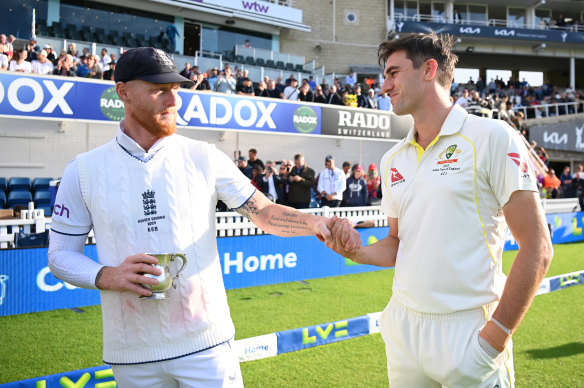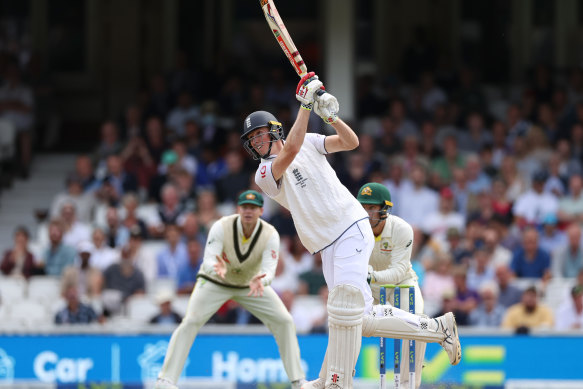A salute to Bazball: It works, damn it
Save articles for later
Add articles to your saved list and come back to them any time.
Ahem, Bazball works. OK, OK, louder: BAZBALL WORKS.
Once fans in each country are done with projecting every known dissolute quality onto the other’s cricketers, and an armistice is called in the phoney cold war, and now that the urn is on its way back to Australia, leaving only its physical manifestation to taunt England for another cycle from a display cabinet at Lord’s, let’s get a bit real.
Cast your mind back to the start of the series. It was clear that Bazball would be the fulcrum. It had been all the rage in England for a year or so and the results were flooding in along with the crowds.
Ah, said every wise Australian head, but wait until it runs up against the hard nuts from Down Under. We’d seen it on TV and it looked fun to play and watch, but lightweight and unsustainable. Implicitly they were saying, watch Bazball disintegrate.
Simply, it didn’t. Bazball didn’t regain the Ashes for England, but 2-2 was not the result Australia sought or expected, either, and when the last ball was bowled, it was the English who were exultant and the Australians who were wandering around with sheepish looks on their faces. It wasn’t so much a last laugh as a self-conscious titter. They’d been be-bazzled.
Australia with the Ashes trophy: muted celebration.Credit: Getty Images.
Sure, many other factors bent an engrossing series this way then that: injury; the toss; overhead conditions; timely and untimely rain; catches held and not held; captaincy sleight of hand; selectorial foibles; capricious balls; even a bit of skulduggery, if that’s what you think it was. You can pull them apart and put them back together in a dozen different ways to make a case for either team’s superiority. That’s the endless fascination of Test cricket.
England were mocked for claims (mostly made on their behalf rather than by them) of moral victory, but the fact is that they held winning positions in all five matches. Australia did not. On balance of play, 2-2 flattered Australia and 3-1 would have been a travesty.
It’s also a fact that in the last month of the series, England thoroughly rattled Australia. Rattling has a particular quality. In 2005, England ambushed a great Australian team with reverse swing and in 2010-11 they ground the struggling Australians into the dirt.
But rattling? That’s usually Australia’s schtick. The harder England went at Australia, the more doggedly, to the point of obstinately, Australia stuck to their guns. It was telling.
Bazball necessarily needs a dab hand to manage. Ben Stokes was that hand. Even Joe Root, his predecessor, says he wishes he’d dared to lead the way Stokes does. He’s the leader of cricket’s post-modernism.
Yes, England’s Bazballing cavaliers screwed up when declaring on day one of the series at Edgbaston, for instance, or by happily hooking themselves to their ruin in the second Test at Lord’s.
But Bazball by its very nature privileges instinct and daredevilry over deliberation and so is bound sometimes to cock up. It’s calculating risk against reward, once also an Australian principle. Australia cocked up just as badly on their anti-Bazball go-slow in the first innings of the fifth Test at the Oval, and it ultimately proved fatal.
Captains Ben Stokes and Pat Cummins after the Ashes.Credit: Getty Images.
Besides, listen to us: tut-tutting about attacking cricket. For most of our lifetimes, Australia have been the natural aggressor and England the conservatives. But ask yourself: do you think Shane Warne would have enjoyed and thrived on Bazball?
Some of the claims made about Bazball were extravagant. It is saving Test cricket? Ashes Test cricket doesn’t need saving. It’s doubtful that Bazball is saving Test cricket where it needs saving. But it is revitalising Test cricket in England, giving it a new aesthetic and a new humour. Much was made of one notorious moment, but this series was played in conspicuously good grace.
(An aside, addressed to the England and Wales Cricket Board: you won’t save Test cricket by getting it out of the way as soon as possible to make room for frolics and frippery. The compression of this series became a deleterious factor in its unfolding.)
Most of all, Bazball is working. Pre Bazball, England had won four of a run of 17 Test matches, including an Ashes walloping in Australia. Since, they’ve won 13, drawn one and lost four, and even the four were memorable. It’s too substantial a body of work now to be dismissed as a gimmick.
Opener Zak Crawley was a poster boy for England’s Bazball batting method during the Ashes series. Credit: Getty
In a roughly contemporaneous stretch, playing a similar suite of opponents, Australia – also under new and enlightened management, remember – have won 10 matches, lost five and drawn five. At this point in history, they’re well met.
Already, the next Ashes series in Australia in 2025 has a different complexion. Both sides will – or should be – be considerably changed by attrition.
The pitches ought to suit Zak Crawley and Harry Brook, and for that matter, Mark Wood and Jofra Archer if they stand up. Wood was one of few to make a good impression here last time.
The retiring and universally admired Stuart Broad called Australia a “beast of a place” to play cricket; he meant it as a compliment. But England have their own beasts now.
But first, while Australia pick themselves up and dust themselves down from their triumph, for England, there’s India. Already a chorus is rising: they won’t dare to play Bazball there. It’ll never work.
Will it?
News, results and expert analysis from the weekend of sport sent every Monday. Sign up for our Sport newsletter.
Most Viewed in Sport
From our partners
Source: Read Full Article



